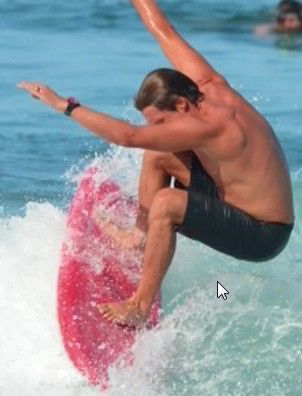
Why a Former Pro Contest Surfer Is Taking a Surfing Lesson
I started surfing frequently when I was 12 and I spent all of my teenage years either surfing or skateboarding. During my 20s I was fortunate enough to obtain surfing sponsors that brought me to wonderful surfing destinations all over the world and supplied me with the best equipment. I surfed many times in professional and invite-only events for both shortboarding and longboarding and even performed well in novelty events such as tandem surfing and stand up bodyboarding. When I wasn’t surfing, I taught surf lessons to newcomers and up and coming surfers with high aspirations.
When I turned 24, I stopped surfing in contests, voluntarily dropped most sponsors and committed myself to the Doctor of Physical Therapy program at Old Dominion University. I imagined that after graduating, I would work full time as a physical therapist but still continue to compete in a few B-list professional contests in Hawaii and do this until I was in my early 40s. But then I had a change of heart…
For the Love Of Surfing
Now at age 32, I am in the best physical shape of my life. Being in the health and wellness field has changed my view of what it means to be at my highest personal athletic performance. Rather than trying to prove myself in professional events, I am surfing for it’s own sake and learning new novel forms of the craft.
Today, I spend my time body surfing large waves and stand up paddling smaller surf in addition to riding a short modern board. I have realized that in order to keep outperforming my 20 year old self, I have to surf smarter and I need to seek out new ways of learning about my technique flaws. There are many learning curves in surfing and getting feedback from friends and other surfers or watching replays captured by Solo Shot / GoPro can help you identify performance gaps that are holding you from the next level.
Physically speaking – surfing in not a difficult sport. Cognitively speaking – surfing may be the single hardest physical activity out there. I believe that most surfers would most greatly improve their performance not through better equipment or finding better waves, but simply spending more time in “deep practice”. The Talent Code by Daniel Coyle speaks volumes about the concept of “deep practice” or in other words increasing your cognitive awareness of what makes someone a better performer. The idea of being process orientated rather than goal orientated. For me, I made the switch of being goal oriented (wanting to win contests) to being process oriented (deeply analysis of technique).
Now instead of worrying about contest results, I focus on timing, exact positioning of my back arm during turns on the wave, breath control when flying down a big wave, etc. As author Daniel Coyle pointed out, learning exact techniques and then spending time repeating and deeply analyzing techniques allows for your body to create more myelin. Myelin insulates nerve fibers, increasing the speed at which impulses are conducted. The more myelin – the faster you can fire nerve impulses / correct mistakes and perfect techniques.
In speaking of technique corrections, many of us saw the video capturing John Florence fracturing his ankle. John Florence is highly regarded as one the best surfers in the world with excellent technique in any conditions. Back in 2013, he was surfing in Australia and performing a routine maneuver when he broke his right ankle. While most of the surf media chalked this injury as a “freak accident”, it is noticeable within the video as to exactly what happened.
Watch his back leg, notice how his hip-knee-foot are not in alignment. If he had pushed his back knee outwards during the aerial rotation it would have most likely avoided the excessive ankle torque that caused the fracture. Basically, instead of his hip pushing outwards to bring the knee and ankle in alignment, his body instead used his knee and shin as a fulcum to destabilize and fracture his back ankle.
Even hearing John’s own explanation of the injury – it doesn’t sound like he had yet figured out that these injuries don’t have to happen. My advice to John would be to practice keeping hip-knee-ankle stability on land as to make proper positioning of his back leg flawless – then slowly translate that positioning into actually riding waves. Because there is so much to think about when riding a wave, proper ergonomic alignment in surfing should be practiced deeply on land and then added into actual surfing.
Movement science can be multi disciplinary. Often I have worked in conjunction with surfing coaches to better a surfer’s performance. A surfing coach can teach the athlete how to add speed, power and flow (contest judging criteria) into their surfing. A physical therapist is better suited though to help an athlete understand how to better command their body and avoid injury while trying seemingly dangerous maneuvers.
From Instructor To Student
Next summer I am finally taking my first surfing lesson. Twenty five years after my first surf session in Cocoa Beach beach I am going to Northern Costa Rica to work with a performance coach. I look forward to finding new ways to accelerate my learning curve. The best athletes are the best because they never stop learning (and figuring out how to avoid injury).
I will be attending the Surf Simply resort in Costa Rica. After listening to many of their podcasts it is apparent that the coaches are truly surf scientists. If there was such a thing as a PhD is surfing, these folks would deserve the title of “Dr.”.
Whether you are a surfer, an athlete or just someone who wants to achieve better balance – never stop learning and know that most injuries are truly avoidable if you have adequate command and understanding over your body.